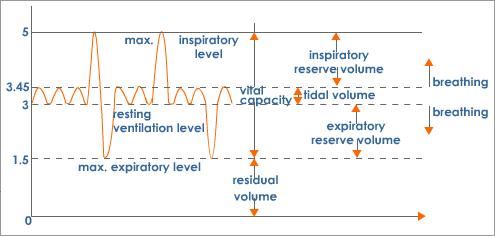The lung capacities of different animals vary based on their activities. E.g., the lung capacity of cheetahs is much higher than humans. This is because they require a large amount of oxygen for their muscles that help them to run fast. The lung capacity of elephants is also higher due to their large body size.
A human lung can hold a maximum of six litres of air. The volume of air involved in the breathing process can be evaluated with the help of a spirometer. It is an equipment which is used to examine the total volume of air inhaled and exhaled by the lungs. It is also used in testing the pulmonary function.
The air in the lungs is measured in terms of lung volume and lung capacity. Lung volume measures the amount of air for inhalation or exhalation. Whereas, lung capacity measures how much air can be inhaled from the end of a maximal exhalation.
Also Read: Mechanism of Breathing
Read on to explore the terms related to lung volume and lung capacity such as tidal volume, residual volume, vital capacity, inspiratory capacity, etc.
Lung Volumes and Lung Capacities

Lung Volumes and Lung Capacities
Lung Volumes
The lung volume can be described by the following terms:
Tidal Volume
The tidal volume is the total amount of air inhaled or exhaled during regular respiration or relaxed breathing. Approximately 500 ml of air is utilized during normal respiration in a healthy man.
Inspiratory Reserve Volume
An inspiratory reserve volume is a supplementary volume, approximately ranging between 2500 to 3100 ml of air which could be effectively inhaled after the inspiration of a standard tidal volume.
Expiratory Reserve Volume
An expiratory reserve volume refers to the additional capacity of air which is about 1200 ml are that could be forcibly exhaled out after the expiration of a standard tidal volume.
Residual Volume/Reserve Volume
The residual volume is about the total volume of air around 1100 ml to 1200 ml residing in the lungs after the reserve volume is emitted or breathed out.
Lung Capacities
The lung capacities can be explained by the following terms:
Total Lung Capacity
The total lung capacity applies to the total volume of air-filled in the lungs after a forced inspiration. The lung capacity of a healthy man is estimated to be 6000 ml.
TLC = TV + ERV + IRV + RV
Vital Capacity
The vital capacity is the total volume of air that can be expired after a maximum inhalation or maximum air that a person can breathe in after forced expiration. It is an important measure of a person’s respiratory health. A decreased vital capacity is an indication of restrictive lung disease where the lungs cannot expand completely. In the case of normal vital capacity, the improper functioning of lungs indicates obstructive lung disease where the lungs are blocked in the airways.
VC = TV + ERV + IRV
Inspiratory Capacity
The inspiratory capacity is the total volume of air that can be inspired which is about 3600 ml.
IC = TV + IRV
Functional Residual Capacity
The functional residual capacity is the total volume of air residing within the lungs after an exhalation process and it is about 2400 ml.
FRC = ERV + RV

The residing air present within the lungs which does not participate in gas exchange is located in the portion of the airways inside the bronchi and bronchioles and outside the alveoli.
Also Read: Lung Diseases
Learn more in detail about the lung volumes and capacities such as vital capacity, tidal volume, etc.. only at BYJU’S Biology

Plse explain the equations given
IC = TV + IRV
TLC = TV + ERV + IRV + RV
FRC = ERV + RV
VC = TV + ERV + IRV